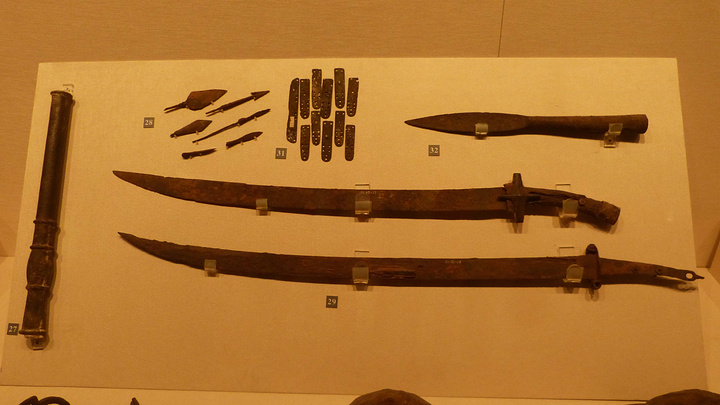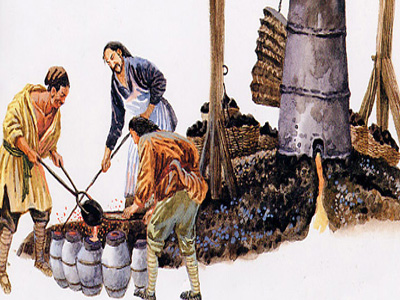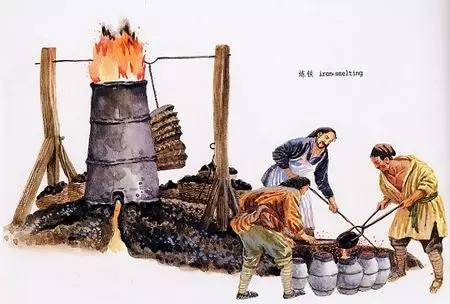Social Reform Triggered by Ironware and 0x-led Plowing
6 min readThe Spring and Autumn Period witnessed profound reforms and changes in ancient Chinese society. Production tool improvement and technical renovation were the underlying motivation for the large-scale social reform.
The Iron Age starts from the Spring and Autumn Period. Hard and sharp ironware replaced wood and stone instruments and was extensively applied in agriculturalproduction. In the Warring States Period, iron plows drawn by two oxen were used. New tools and improved plows promoted cultivation technology. However, traditiona mass cultivation seriously hindered the popularization of new technology. The historical records of “slow for collective cultivation while quick for private land”reflect the profound reform of large-scale compulsory collective cultivation replaced by individual plowing. Thanks to the efficiency of iron tools and ox-led plowing,a great deal of barren land was reclaimed in this period. The products reaped from the extra private land were no longer presented to the kings. Owners of these private lands leased their lands to peasants for collecting rent, resulting ina new production management mode, which greatly aroused the production enthusiasm of individual peasants. Low-efficient, backward collective cultivation for “public fields”was strongly opposed, leading to stretches of uncultivated land withwidespread weeds. The vassals, therefore, had to lease the “public fields”to peasants for cultivation, marking the collapse of the “square-fields system.” Landowner economy, based on land privatization and individual cultivation, rapidly expanded.

The booming landocracy intensively required to break the old system of the patriarchal nobles’ hereditary occupation of fiefs and military and political power, abolish their hereditary privileges in position and salary and initiate reforms aimed at developing a landocracy economy, enriching the country and forging a mighty army.
Guan Zhong of the State of Qi in the Spring and Autumn Period initiated the policy of “collecting tributes and taxes according to the size and quality ofland.”The State of Lu implemented the policy of “initial tax on land per-mu,” which provided that taxes should be levied based on actual land size regardless of ownership of the land. These tax reforms, in nature, confirmed land privately owned in the form of state laws. Later on, the State of Qin launched the land policy of”destroying square fields and allowing land sales,”which further legalized and popularized the privately-owned land and paved the way for the state’s ruling over land owners.

Li Kui, named by Marquis Wen of the State of Wei in the Warring States Period, worked out The Book of Law to beef up the landocracy ruling legally. King Dao of the State of Chu appointed Wu Qi to carry out a renovation with the goal of changing the old hereditary fief and official administration systems and consolidating the centralized monarchy. The reform confronted fierce resistance due to the damage to the interests of the old nobles. For instance, after King Daowang of the State of Chu passed away, the conservative side killed Wu Qi with arrows. Wu had been hiding at the side of the King’s body for shelter, He was killed despite the penalty of family extermination for damaging the king’s body. However, after many setbacks, reforms won obvious effects in Qi, Jin, Zheng, Wu, Yue, Wei, Chu, Qin, Han, Zhao, Yan and other vassal states, including Shang Yang’s Political Reform in the State of Qin in the middle Warring States Period.
In BC 356, Marquis of Xiao of the State of Qin appointed Shang Yang to launch a political reform. The main contents of the reform included awarding cultivation and battle feats, abolishing the square-fields system and the field boundaries and establishing a county system. The new law abolished the hereditary position and salary system and set up 20 ranks for corresponding political and economic privileges to be awarded equally according to feats. The reform attacked the nobles’ privileges and improved the morale and battle-effectiveness of the army. It also ruled that those having high output of grain and cloth would be exempt fromduty service and taxes, playing the function of inspiring production activity and improving state power.”Abolishing the square-fields system and the field boundaries”refers to opening the boundaries of the square-fields occupied by the nobles and admitting the legality of private land to promote the development of landocracy. The new law also divided the State of Qin into 31(or 41) counties to replace the fief system. The county magistrates and assistants were appointed anddismissed by the king and no heredity was allowed. The State of Qin also compiled household registration and implemented penalties to implicate others related to the one charged or found guilty. Normally five or 10 families formed a unit for supervising each other. In addition, Shang Yang formulated Qin Rules and promulgated uniform metrology standards, making great contributions to unification.

Shang Yang performed two stages of reform in the State of Qin for 20 years, making Qin gradually powerful and rich. Shang Yang executed laws rigidly and cut of the nose and tattooed the face of the Prince’s tutor of anyone who suborned the Prince to block the reform. When the Prince came into power, Shang Yang was torn asunder by five carts. But the laws continued and the new policies prevailed. The rapid rise of Qin in the remote western areas in the later period of the Warring States was largely attributed to the profound influence of Shang Yang’s new policy.A century after the death of Shang Yang, King Ying Zheng of Qin took advantage ofthe influence of Shang Yang’s reform that helped accelerate the pace of national unification.
First, Qin paid great attention to agriculture, laying a solid economic foundation for unification. The Dujiangyan Irrigation Project built by Qin’s ShuCounty Major Li Bing is still irrigating thousands of mu of land and making the Chengdu Plain a fertile place where people no longer suffer starvation caused by drought and flood. The Zhengguo Channel, constructed in the Weihe River Plain underthe leadership of Zheng Guo, irrigated 2.8 million mu of farmland, creating another enormous granary in the central Shanxi Plain.
The policy of honoring military exploits forged a brave army. The tri-ridgearrows unearthed from the Qin’s terracotta warriors and horses pit had the sharpness to penetrate armors, which is proof of the brave Qin army’s fine range oi weapons. The six states’ military force had a reputation for never escaping in the face of the Qin’s army, as it was like “putting a heavy weight on bird’s eggs.” Opening and enterprising policies and absorbing the merits of other states were important reasons for Qin’s unification. In BC 238,a time shortly after King Ying Zheng of Qin came into power, the state of Han sent Zheng Guo to persuade Ying Zheng to dig a channel in the Jinghe basins to divert water for irrigation. This request was actually intended to exhaust the national strength of Qin and hinder its pace of marching eastward. But the plot failed before the channel was built. Facing the penalty, Zheng Guo said building the channel could do nothing but offer a few years more for the State of Han even though it consumed lots of fiscal revenue. But forthe State of Qin, the great project would benefit later generations. Hearing this, the king of Qin changed his mind and let Zheng Guo continue its construction. However, patriarchal ministers argued that Qin’s alien ministers should be dismissed since they came to Qin for persuasion and alienation. Li Si, an alien minister from Chu, submitted Remonstrance on Dispelling Alien Ministers to disprove them with the instances that the kings of Qin utilized alien ministers to build Qin. Then Ying Zheng became aware of the importance of alien ministers and cancelled the order for dispelling ministers and called Li Si back. He and other alien ministers played an active role in helping Ying Zheng unify the other six states into one country.
From BC 230 to BC 221, Ying Zheng directed his army to conquer six states and established the first centralized empire in Chinese history.
Instances of vassals contending for hegemony and progress in social reform were interwoven into the period. Collapsed ritualism and musical systems and social turmoil offered an open space for reform in states. Reform was the only way to make the country and army powerful and win the competition in the chaotic situation. Warfare for merging and seizing power was endowed with the added significance of expanding reform and new policy. On the basis of destroying the old system, the newunification made by the emerging landocracy showed the people’s will and promoted the huge progress of society.








